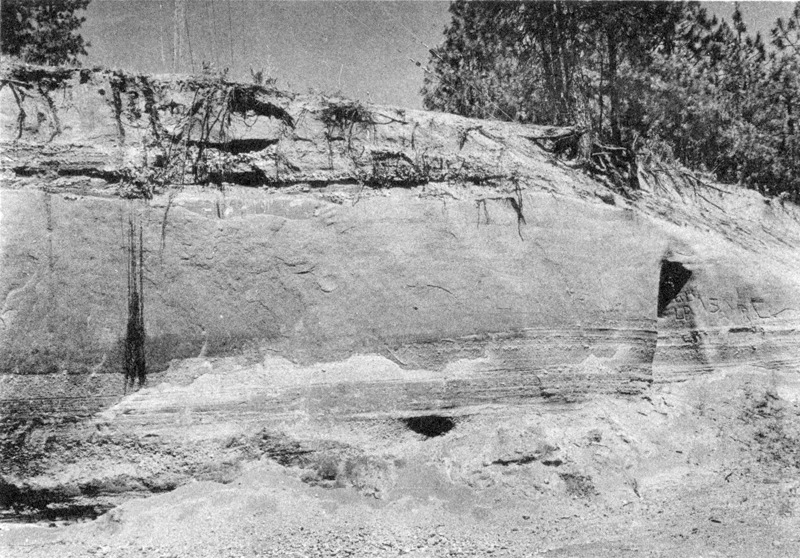The branching tongues of the pumice flow, having diverged below Union Creek, converged again at Prospect, where they tumbled into the main canyon of the Rogue. This they followed for another 8 miles. Along this stretch of the river most of the deposits have been washed away, but there are many places where pumice benches are still preserved. Near the Prospect Power House, for example, there are benches 150 feet above the river, and at Laurelhurst, a few miles lower, there are benches 100 feet above the river. These indicate the original thickness of the flows at those points. Not until the flows reached the junction of the Rogue with Cascade Creek, where the main river leaves its basaltic gorge and enters an older and broader valley through the Western Cascades, were they able to spread out again. Here their remains form wide flats 50 to 80 feet above the river.
Suddenly the flows come to an end, 1 1/2 miles above McLeod. Fortunately a roadside quarry and deep road cuts offer excellent opportunity for study of these terminal deposits. These show, as might be expected, an extremely high content of fine pumice dust. The flows had traveled so far, and the larger pumice lumps had been so reduced in number and size by internal explosions and mutual bombardment, that much of the material was reduced to powder. Whereas half the material in the flows above Union Creek may be composed of pumice bombs more than an inch across, the proportion of such bombs at the snout of the flows rarely exceeds 10 per cent. A sample from the roadside quarry near the snout shows the following content by volume: less than 0.5 mm., 70 per cent; 0.5-1 mm., 8 per cent; 1-3 mm., 13 per cent; 3-5 mm., 3 per cent; 5-10 mm., 3 per cent; and greater than 10 mm., 3 per cent. Moreover, the content of lithic fragments is much less than in the flows nearer the source, and few exceed even 1 mm. in size. In a second sample from the same quarry, 41 per cent of the material was less than 0.125 mm. in size, and all fragments larger than 5 mm. were composed of pumice. Though lithic material made up 16.7 per cent of the fraction between 0.125 and 5 mm., the total lithic content in the deposit was only about 6 per cent. Histogram 361, figure 25, shows the nature of the finer constituents. Finally, it should be added that charcoal logs, some of them 3 feet across, are almost as plentiful at the snout of the flows as anywhere higher up the valley of the Rogue.
The choking of the Rogue River gorge by a mass of pumice up to 150 feet in thickness must have produced extensive floods. Much of the pumice must have been swept downstream immediately and more has since been removed. Accordingly, terraces of washed pumice occur far below the snout of the flows. For instance, an excavation along the roadside close to the Rogue-Elk junction shows reassorted, bedded pumice about 50 feet above the level of the river (plate 19, figure 2). Pumiceous sand and gravel border the river at least as far down as the Agate Desert, near Medford.
|
Plate 19. Fig. 2. Washed and bedded pumice deposits, in a roadside quarry near Rogue-Elk junction, Medford highway, a few miles below the snout of the Rogue River pumice flow. Essentially a mass of rolled pumice fragments, mixed with andesitic gravel and containing many chips of charcoal washed from the pumice flows upstream. |
***previous*** — ***next***


